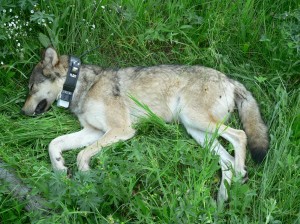Wolf 341F earned my admiration. Like early pioneers or explorers, she (in the words of Mark Twain), “lit out for the territory ahead of the rest,” with a wanderlust to venture into the unknown. Here's her tragic story:

And one intrepid wolf from the Yellowstone area certainly proved his characterization correct. Bounding across some of the west’s most remote wilderness, wolf 341F embarked on a meandering excursion of over 3,000 miles through five states on her seven-month journey from Yellowstone to Colorado in the winter of 2008/2009. This remarkable 18-month-old female covered an incredible distance in search of a mate and new territory. Although wolves can travel up to thirty miles a day, the animals rarely venture more than sixty miles from their base pack.
In February of 2009, signals from her radio collar indicated she remained about 120 miles west of Denver. The public avidly followed her travels as Colorado’s last native wolf had been killed in 1943. Then sadly 341F was found dead just a month later. Gary Wockner, a former member of the Colorado Wolf Working Group spoke about her death, "This adventurous wolf sparked Colorado's imagination. She made us think about what Colorado is missing without its wolves."
At the time the cause of 341F’s death was unknown. This week, however, officials at the U.S. Fish and Wildlife Service released the results of their investigation. Toxicology tests performed at the National Fish and Wildlife Forensic Laboratory showed the two-year-old gray wolf, which had been captured and collared as part of a Montana research project, died from ingesting a banned poison known as Compound 1080. It is suspected the wolf ingested the poison near the site where she was found.
With the investigation more than a year and a half old, investigators are now asking the public for information about the case. "When used improperly, Compound 1080 is an indiscriminate killer of wildlife, and we are asking the public to help us identify who used this banned poison in Colorado," said Steve Oberholtzer, Special Agent in Charge for the U.S. Fish and Wildlife Service’s Mountain-Prairie Region.
Compound 1080 was commonly used in the United States prior to 1972 for controlling rodents and livestock predators such as coyotes and foxes. It was banned in the U.S. in 1972, but the rule was modified in 1985 to allow the poison to be used in some states for predator control in a highly regulated fashion. Compound 1080 is currently illegal to use in the state of Colorado.
Anyone with information regarding this wolf’s death that would be useful to investigators is urged to contact either the Colorado Division of Wildlife’s Operation Game Thief hotline number at (877) 265-6648 and/or the U.S. Fish and Wildlife Service at (720) 981-2777.
